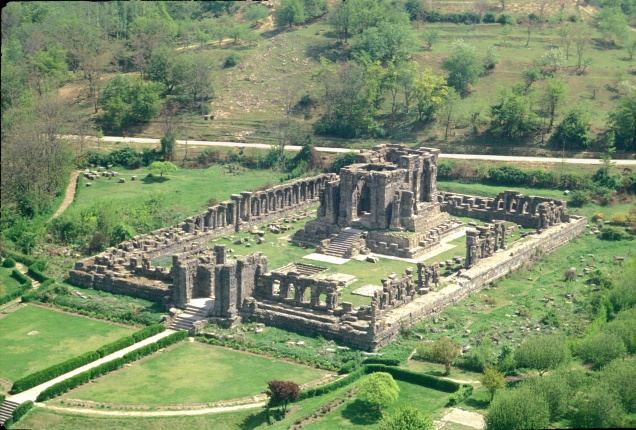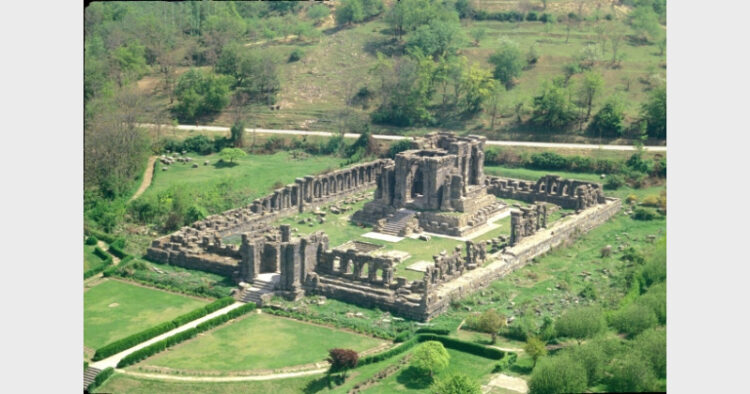
Kashmir, the once cultural and knowledge capital of India had been under civilisational decline for the past few centuries. Multiple invasions and the subsequent reign of outsiders reduced the land of great ‘Tantric traditions’ into a graveyard of Indic antiquity. Systematic efforts were made (or are being made) to cut Kashmir from its roots, like an alien culture masquerading to be indigenous and distortion of history to suit the invader’s interests. But what lies beneath the Chinar leaves is the tale of Kashmir’s dynamic past, largely ignored by India’s academic intelligentsia.
There is a popular misconception among western scholars that Indians lack any sense of their own history. Contrary to that perception, Rajatarangini, a 12th-century book written by Kalhana gives a 5000-year-old history of Kashmir. The book shares valuable information regarding Kashmir’s successive dynasties, sacred places, geography and its economy. Kalhana had relied upon his preceding historical sources including Nilamata Purana (C.E 6 century – 8 century), Nripavali and Parthivavali to depict Kashmir’s political cum cultural transition. What we understand from these illustrious sources is the existence of a well defined socio-cultural structure in ancient Kashmir and a disruption to it post the establishment of Shah Miri dynasty in the 14th century C.E.

Kashmir’s culture is a close synchronisation of Shaivism and Buddhism. The name Kashmir itself comes from Rishi Kashyapa, who was one among the Sapthrishis. Naga cult was the primitive form of worship in Kashmir (Chib, 2007). Following the Vedic period, Buddhism spread throughout Kashmir owing to the state patronage. Rajatarangini mentions that during the rule of Ashoka, a large number of Buddhist stupas were erected in Kashmir. He also constructed Hindu temples dedicated to Lord Shiva. Later these temples were rebuilt by Raddadevi, the queen of Jayasimha (Pandit, 1935). Ashoka had invited Buddhist monks from Kashmir to attend the Third Buddhist council held at Pataliputra (present-day Patna). Also, the fourth Buddhist council was held at Kundalavana near Kashmir in 1st Century CE under the patronage of Kushana ruler Kanishka and supervision of Vasumithra and Asvaghosa. Nilamata Purana, which gives details about Kashmir’s cultural past referred to Buddha as an incarnation of Lord Vishnu (Warikoo, 2009). The co-existence of these two Indic religions flourished the region for centuries.
Shaivism emerged as a dominant spiritual path at the beginning of 5th-century C.E in Kashmir. Tryambagaditya, who was a disciple of Durvasa became the first preacher of the Kashmiri school of Shaivism. This school of thought considers Shiva as the supreme reality and connects an individual’s inner self to that universal soul. Its resemblance with Advaitha Vedanta cannot be ignored as Advaitha forms the very base of Sufism in Kashmir. Bhakti movement was at its peak in 12th-13th centuries, hence Hindu teachings influenced Muslims and Sufism was a by-product of that amalgamation (Dhar, 2009). It is this connection with Indian philosophy that makes Sufis heretics in the eyes of orthodox Muslims. Sheikh Noor-ud-Din Noorani, also known as Nund Rishi was a Kashmiri Sufi saint revered by both Hindus and Muslims alike. He was spiritually inspired by Saivite mystic Lalleshwari, the pioneer of Bhakti movement in Kashmir.
Sharada Peeth, presently located in Pakistan Occupied Kashmir, 10-kms from the Line of Control, was an ancient temple cum knowledge centre (Rehman, 2017). ‘Sarvajna Peetham’ was a test at Sharada Peeth which only a learned man could pass. The temple was dedicated to goddess Saraswati, the Hindu goddess of Knowledge. Adi Shankara, a young philosopher from Kerala reached Kashmir, debated with Pandits and other learned men to attain Sarvajna Peetham. Such was the thirst for knowledge our civilization had. But after a few centuries, our universities and its libraries were burnt down by the outsiders, for whom gold and precious stones were the only forms of wealth.
Many great literary works in Sanskrit were produced from Kashmir. It included books on poetry, phonetics, grammar, medicine and philosophy. All the six schools of Sanskrit poetry Alamkara, Riti, Rasa, Dhvani, Vakrokti and Aucitya had its origin in Kashmir (Ghai, 2009). Commentaries on Panini’s Astasdhyayi and Patanjali’s Mahabhasya were also composed there. Samyamatrika written by Kshemendra gives details about Kashmir’s topography. Somadeva, who wrote Kadhasaritsagar mentioned some of the holy places like Varahkshethra, Nandikshethra, Uttarmanasa and the down of Hiranypura (Kalla D. B., 2012). The genre of Kashmiri writers ranged from the dramas of Kalidasa (Kalla L. D., 1926) to the love poems of Bilhana to the Shiva Sutras of Vasugupta. These Sanskrit textbooks are not just great literary pieces but also provide us with enormous information regarding the culture, history, topography, geography and social life of Kashmir.
Kashmir was home to magnificent temple structures prior to the beginning of Muslim rule. Sikandar Shah Miri, also known as the Sikandar Butshikan (the iconoclast) destroyed iconic temples including Martand Sun Temple, Bahrane Mahadeva temple, and temples of Chakradhara, Sureshwara and Tripureshwara. Hindus were selectively targeted, converted and those who refused to convert were killed. Jizya was imposed on non-Muslims and Syed Ali Shah Hamadani was brought in to convert Brahmins to Islam (Tikoo, 2012). The medieval rulers of Kashmir like their Delhi Sultanate counterparts (followed by Mughals) were intolerant towards non-Muslim subjects and their places of worship.
What is being exhibited today as ‘Kashmiriyat’ is the pseudo imagery of an alien culture. Anything connected to its Hindu past is mutilated and presented in a much different form. Thousands of villages in Kashmir that bore Hindu names were reverted to give Islamic names during the rule of National Conference. Kashmiri Pandits were forced to exit the valley in the 1990s. Temples were destroyed and Hindu scholars of the valley were targeted. Islamists and their apologists have created propaganda of Hindu India subjugating Muslim Kashmir, a claim that can be proved bogus from the real history of Kashmir. Kashmir is a living example of an indigenous faith replaced by an aggressive- religious framework and its failure to manage the domestic population. A revival of Kashmir’s ancient culture could end the radicalisation and ongoing fundamentalist menace in the Kashmir valley. The land of Kashyapa shall reclaim its lost glory only when the errors of the past few centuries are reversed in due course of time.
—————————————————————————————————-
Bibliography
Chib, M. (2007). Naga Worship in Jammu & Kashmir. International Journal of Research and Analytical Reviews, 467 – 469.
Dhar, T. (2009). Influence of Advaita on Muslim Rishis of Kashmir. In K. Warikoo, The Cultural Heritage of Jammu and Kashmir (p. 101). New Delhi: Pentagon Press.
Ghai, V. K. (2009). Kashmir: The Land of Sanskrit Poetry and Poetics. In K. Warikoo, The culture and heritage of Kashmir (p. 71). New Delhi: Pentagon Press.
Kalla, D. B. (2012). Koshur Samachar. Retrieved from koausa: http://www.koausa.org/KoshSam/SanskritLiterature.html
Kalla, L. D. (1926). The Birthplace of Kalidasa. Delhi: Imperial book depot press.
Pandit, R. S. (1935). River of Kings (Rajatarangini). Allahabad: The Indian Press.
Rehman, F. u. (2017). Peace & Economy beyond Faith: A Case Study of Sharda. Pakistan Vision.
Tikoo, C. T. (2012). Kashmir: Its Aborigines and their Exodus. New Delhi: Lancer InterConsult.
Warikoo, K. (2009). Buddhist Heritage of Kashmir. In A. Kaul, Cultural heritage of Jammu and Kashmir (p. 324). New Delhi: Pentagon Press.
******************************************************************














Comments